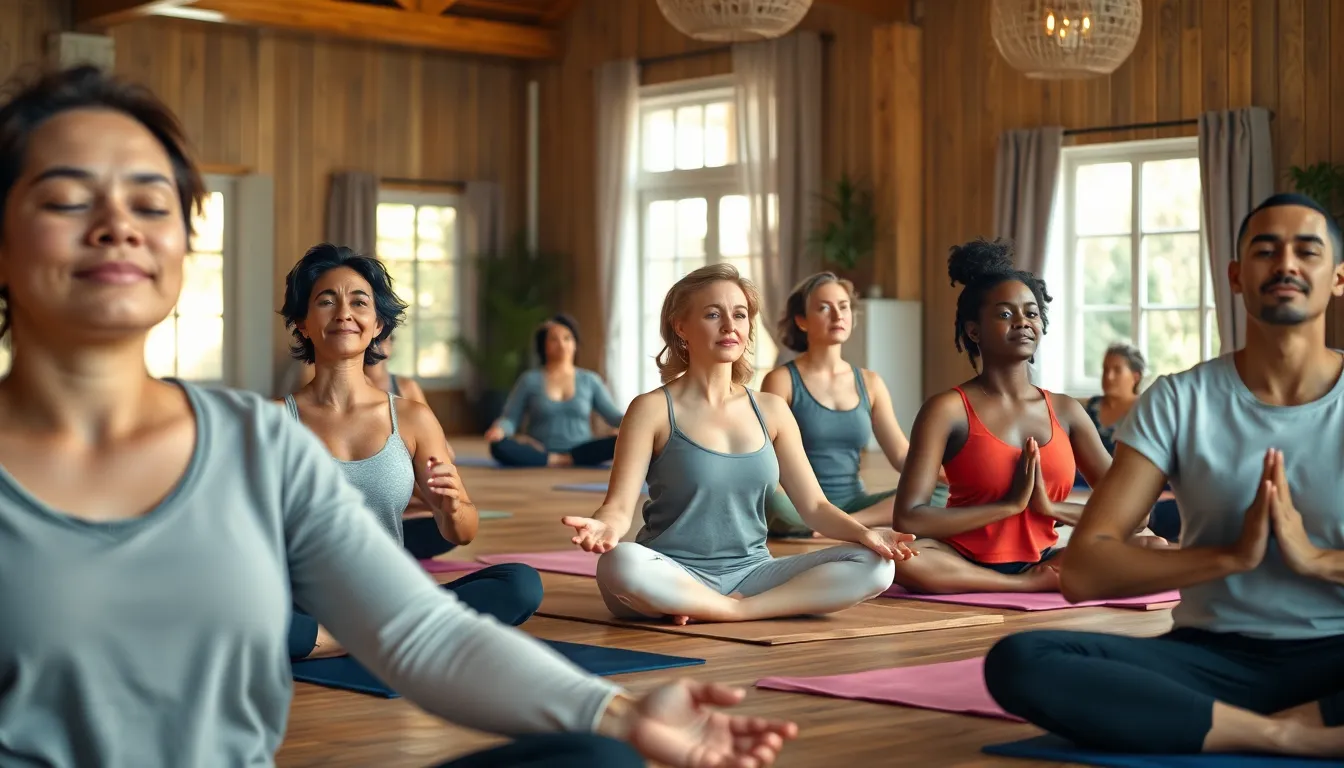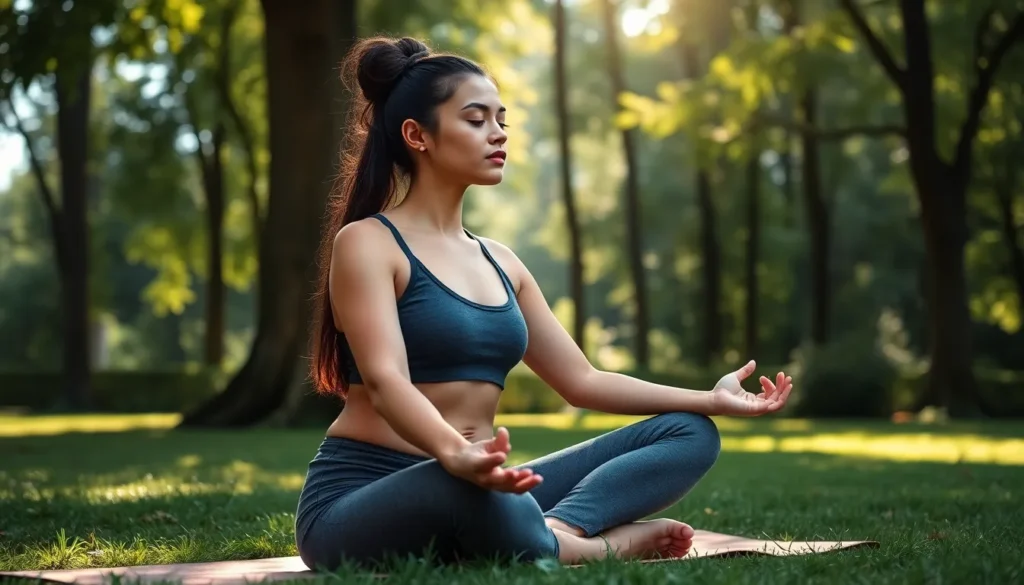Table of Contents
ToggleIn today’s fast-paced world, stress has become an unwelcome companion for many. Finding effective relaxation methods is essential for maintaining mental and physical well-being. Whether it’s the pressures of work, family responsibilities, or the constant buzz of technology, individuals often seek ways to unwind and recharge.
From mindfulness practices to physical activities, various techniques can help alleviate tension and promote a sense of calm. Exploring these methods not only enhances overall health but also improves focus and productivity. Embracing relaxation isn’t just a luxury; it’s a vital component of a balanced lifestyle.
Overview of Relaxation Methods
Relaxation methods encompass various techniques designed to reduce stress and promote a state of calm. These methods can enhance mental clarity, improve emotional health, and contribute to overall physical well-being.
Mindfulness Practices
Mindfulness practices focus on maintaining a moment-to-moment awareness. Techniques include:
- Meditation: Engaging in focused breathing and awareness of thoughts enhances mental clarity.
- Yoga: Combining physical postures with breath control and meditation promotes relaxation and flexibility.
- Guided Imagery: Visualizing peaceful scenes can reduce anxiety and encourage tranquility.
Physical Activities
Physical activities not only boost fitness but also relax the mind. Consider these options:
- Walking: A brisk 30-minute walk can elevate mood and reduce stress hormones.
- Swimming: Immersing in water provides a soothing effect on the body and mind.
- Dance: Expressive movements release endorphins, fostering joy and relaxation.
Breathing Techniques
Breathing techniques aim to regulate stress responses. Common methods include:
- Deep Breathing: Taking slow, deep breaths activates the body’s relaxation response.
- Box Breathing: Inhaling for four counts, holding for four, exhaling for four, and holding again promotes calmness.
- Alternate Nostril Breathing: Balancing breath through each nostril can enhance focus and reduce tension.
Nature Exposure
Spending time in natural environments offers significant relaxation benefits. Activities include:
- Nature Walks: Walking in parks or forests has been shown to elevate mood and decrease stress levels.
- Gardening: Engaging hands in soil provides therapeutic effects and fosters a sense of connection to nature.
- Outdoor Meditation: Practicing meditation amidst natural surroundings deepens relaxation experiences.
Utilizing these relaxation methods can lead to improved health and overall quality of life, making them essential for managing daily stressors effectively.
Benefits of Relaxation Methods

Relaxation methods offer substantial benefits for both physical and mental health. These techniques can improve overall well-being and enhance the quality of life.
Physical Health Benefits
- Reduces Muscle Tension: Relaxation techniques like yoga and progressive muscle relaxation decrease muscle tightness, leading to relief from physical discomfort.
- Lowers Blood Pressure: Engaging in regular relaxation practices can lead to lower blood pressure readings, which can reduce the risk of cardiovascular issues.
- Boosts Immune Function: Relaxation fosters a stronger immune response by decreasing stress hormones, which can improve overall health and resilience against illness.
- Alleviates Pain: Techniques such as meditation and deep breathing help manage chronic pain conditions by altering the perception of pain and reducing stress-related pain responses.
- Enhances Sleep Quality: Incorporating relaxation methods into daily routines promotes better sleep patterns, aiding in quicker sleep onset and longer, more restful sleep.
Mental Health Benefits
- Reduces Anxiety: Mindfulness practices, including meditation and guided imagery, help lower anxiety levels by promoting a sense of calmness and clarity.
- Improves Focus and Concentration: Regular relaxation enhances cognitive function, making it easier to concentrate on tasks and improve productivity.
- Boosts Emotional Well-being: Relaxation methods promote positive moods and emotional resilience by decreasing stress and enhancing self-awareness.
- Fosters Creative Thinking: Engaging in relaxation activities encourages creative problem-solving by allowing the mind to wander and explore new ideas without constraints.
- Enhances Social Connections: Participating in group relaxation activities, such as yoga classes or guided meditation, can strengthen social ties and build a supportive community.
Popular Relaxation Methods
Various methods exist for relaxation, each targeting stress relief and fostering mental and physical well-being. Below are some popular techniques that can effectively reduce tension.
Deep Breathing Techniques
Deep breathing techniques promote relaxation by focusing on breath control. Practitioners inhale deeply through the nose, expanding the diaphragm, and then exhale slowly through the mouth. Techniques like abdominal breathing, 4-7-8 breathing, and box breathing help lower heart rate, decrease anxiety, and enhance overall calmness. The simplicity and accessibility of these techniques make them suitable for any setting.
Progressive Muscle Relaxation
Progressive muscle relaxation (PMR) involves systematically tensing and then relaxing different muscle groups throughout the body. This technique helps individuals recognize and mitigate physical tension. Practitioners usually start from the toes and work their way up to the head, focusing on areas like the arms, shoulders, and face. PMR can effectively alleviate muscle tension and improve awareness of the body’s stress response.
Meditation Practices
Meditation practices encompass various techniques designed to enhance mindfulness and inner peace. Popular methods include mindfulness meditation, transcendental meditation, and loving-kindness meditation. Each practice involves focusing attention, observing thoughts without judgment, and cultivating a sense of calm. Regular meditation can lead to reduced stress levels, improved emotional health, and heightened focus and concentration.
Yoga and Stretching Exercises
Yoga and stretching exercises combine physical movement with breath awareness to enhance relaxation. Various styles exist, including Hatha, Vinyasa, and Yin Yoga, each offering unique benefits. These practices improve flexibility, reduce muscle tension, and promote mental clarity. The integration of mindful breathing in yoga creates a harmonious balance between body and mind, fostering overall relaxation.
Choosing the Right Relaxation Method
Selecting an appropriate relaxation method involves understanding personal preferences and lifestyle factors. These elements play a crucial role in determining which techniques will yield the best results for stress management.
Personal Preferences
Personal preferences greatly influence the effectiveness of relaxation methods. Identifying what resonates most with an individual can enhance their commitment to a chosen technique.
- Activity Type: Some may prefer quiet practices like meditation, while others favor more active methods like yoga or dancing.
- Environment: Individuals may find relaxation in serene environments, such as gardens or quiet rooms, while others thrive in dynamic settings filled with music and social interaction.
- Duration: Preferences for the length of practice vary. Some people seek quick, 5-minute techniques, while others prefer longer sessions lasting 30 minutes or more.
Lifestyle Considerations
Lifestyle considerations affect the feasibility and sustainability of relaxation methods. Keeping these factors in mind ensures a realistic approach to integrating relaxation into daily routines.
- Schedule: A busy lifestyle may necessitate shorter, more accessible practices like deep breathing or quick meditation sessions.
- Physical Capabilities: Some methods, such as yoga or exercise, require certain physical abilities. It’s essential to choose techniques that accommodate these capabilities to prevent injury and promote enjoyment.
- Social Engagement: Individuals who thrive on social interactions might prefer group activities, such as dance classes or outdoor meditation sessions, while those who favor solitude may gravitate towards solitary practices like journaling or guided imagery.
Incorporating personal preferences and lifestyle considerations leads to more effective and enjoyable relaxation methods, ultimately fostering a balanced approach to stress management.
Incorporating effective relaxation methods into daily life is vital for maintaining both mental and physical health. By exploring various techniques and finding what resonates personally, individuals can significantly reduce stress and enhance their overall quality of life. Whether it’s through mindfulness practices, physical activities, or simple breathing exercises, the key lies in consistency and commitment.
Embracing relaxation not only improves focus and productivity but also fosters emotional well-being and social connections. As people navigate the challenges of a fast-paced world, prioritizing relaxation can lead to a more balanced and fulfilling lifestyle. Making time for these practices is an investment in health that pays dividends in every aspect of life.



